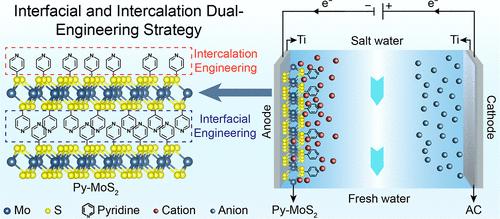Boosting Capacitive Deionization in MoS2 via Interfacial Coordination Bonding and Intercalation-Induced Spacing Confinement
IF 16
1区 材料科学
Q1 CHEMISTRY, MULTIDISCIPLINARY
引用次数: 0
Abstract
Capacitive deionization (CDI) is a green and promising technology for seawater desalination, with its capacity and industrial application being severely hindered by efficient electrode materials. Layered molybdenum disulfide (MoS2) has garnered significant attention for CDI applications, while its performance is hampered by weak surface hydrophilicity, high interfacial resistance, and sluggish electron transport. Herein, we introduce an interfacial and intercalation dual-engineering strategy by covalently functionalizing the hydrophilic pyridine groups within the 1T-MoS2 layer (Py-MoS2); an electron-rich interface with an expanded interlayer spacing has been achieved synergistically. A state-of-the-art high desalination capacity of 43.92 mg g–1 and exceptional cycling stability have been achieved, surpassing all of the reported existing MoS2-based CDI electrodes. Comprehensive characterization and theoretical modeling reveal that covalently engineered pyridine groups enhance ion affinity via interfacial coordination, accelerate charge transfer, and expand ion-accessible sites within the MoS2 interlayer spacing through intercalation-induced structural modulation. These synergistic effects dramatically boost the ion adsorption kinetics, mass transfer efficiency, and salt ion uptake capacity within Py-MoS2 for CDI application. Our work presents an interfacial and intercalation dual-engineering strategy to promote the seawater desalination of 2D materials, paving new insights for next-generation high-performance CDI electrode development.

界面配位键和插层诱导的间距限制促进MoS2的电容性去离子
电容式去离子(CDI)是一种绿色且有发展前景的海水淡化技术,但其容量和工业应用受到高效电极材料的严重阻碍。层状二硫化钼(MoS2)在CDI中的应用备受关注,但其性能受到表面亲水性弱、界面电阻高和电子传递缓慢的限制。在此,我们通过在1T-MoS2层(Py-MoS2)内共价功能化亲水性吡啶基团,引入了界面和插层双工程策略;通过协同作用,扩大了层间距,形成了富电子界面。该技术具有43.92 mg g-1的高脱盐能力和卓越的循环稳定性,超过了所有现有的mos2基CDI电极。综合表征和理论建模表明,共价工程吡啶基团通过界面配位增强离子亲和力,加速电荷转移,并通过插层诱导的结构调制扩大MoS2层间距内离子可达位点。这些协同效应极大地提高了离子吸附动力学,传质效率和盐离子吸收能力在Py-MoS2中用于CDI应用。我们的工作提出了一种界面和嵌入双工程策略,以促进二维材料的海水淡化,为下一代高性能CDI电极的开发提供了新的见解。
本文章由计算机程序翻译,如有差异,请以英文原文为准。
求助全文
约1分钟内获得全文
求助全文
来源期刊

ACS Nano
工程技术-材料科学:综合
CiteScore
26.00
自引率
4.10%
发文量
1627
审稿时长
1.7 months
期刊介绍:
ACS Nano, published monthly, serves as an international forum for comprehensive articles on nanoscience and nanotechnology research at the intersections of chemistry, biology, materials science, physics, and engineering. The journal fosters communication among scientists in these communities, facilitating collaboration, new research opportunities, and advancements through discoveries. ACS Nano covers synthesis, assembly, characterization, theory, and simulation of nanostructures, nanobiotechnology, nanofabrication, methods and tools for nanoscience and nanotechnology, and self- and directed-assembly. Alongside original research articles, it offers thorough reviews, perspectives on cutting-edge research, and discussions envisioning the future of nanoscience and nanotechnology.
 求助内容:
求助内容: 应助结果提醒方式:
应助结果提醒方式:


